#Infrared Data
Explore tagged Tumblr posts
Text
https://www.futureelectronics.com/p/semiconductors--comm-products--phy/ksz8721bli-tr-microchip-2178564
Computer networking, Ethernet controller, Ethernet MAC controller, Infrared Data
KSZ8721B Series 2.5 V 10/100 Base TX/FX Physical Layer Transceiver - LQFP-48
#Microchip#KSZ8721BL#Comm Products#PHY#Computer networking#Ethernet controller#Ethernet MAC controller#Infrared Data#physically connects devices#digital signal processor#industrial equipment#digital data#High-level Internet#network interface card
1 note
·
View note
Text
I don’t have a posted DNI for a few reasons but in this case I’ll be crystal clear:
I do not want people who use AI in their whump writing (generating scenarios, generating story text, etc.) to follow me or interact with my posts. I also do not consent to any of my writing, posts, or reblogs being used as inputs or data for AI.
#not whump#whump community#ai writing#beans speaks#blog stuff#:/ stop using generative text machines that scrape data from writers to ‘make your dream scenarios’#go download some LANDSAT data and develop an AI to determine land use. use LiDAR to determine tree crown health by near infrared values.#thats a good use of AI (algorithms) that I know and respect.#using plagiarized predictive text machines is in poor taste and also damaging to the environment. be better.
292 notes
·
View notes
Text
Protecting Polar Bears With Improved Radar Technology - Technology Org
New Post has been published on https://thedigitalinsider.com/protecting-polar-bears-with-improved-radar-technology-technology-org/
Protecting Polar Bears With Improved Radar Technology - Technology Org
Research testing new technology to more effectively locate polar bear dens across the Arctic is showing promising results.
Researchers from Simon Fraser University (SFU) and Brigham Young University (BYU), collaborating with Polar Bears International, hope that improving detection tools to locate dens—which are nearly invisible and buried under snow—will help efforts to protect mother polar bears and their cubs.
A Polar bear – illustrative photo. Image credit: Pixabay (Free Pixabay license)
Results of a pilot study aimed at improving den location in Churchill, Manitoba—using ARTEMIS Inc., an imaging system that relies on Synthetic Aperture Radar, or SAR—are published in the journal URSUS just ahead of Polar Bear Week (Oct. 29 – Nov. 4).
The team found that SAR increased den detection by more than 20 per cent, or 66 per cent, compared with the industry’s current 45 per cent accuracy rate using the aerial Forward Looking Infrared (FLIR) system as a den-detection tool.
“Our airborne imaging radar system has multi-band, interferometric, and polarization capabilities at microwave frequencies able to penetrate snow,” says SFU engineering science professor Bernhard Rabus, who holds an Industrial Research Chair in Synthetic Aperture Radar. “The system can ‘see’ both the top snow surface, the den roof surface and inside the den cavity.”
“While our method is still in its research and testing phase, an operational version is expected to be able to extrapolate from the radar signatures of live bears in the open, combined with computer modelled den cavity radar signatures, to develop a robust match filter detection for airborne multi-channel SAR data to detect polar bears reliably inside their dens.”
Unlike aerial FLIR, SAR technology performs well regardless of temperature and weather conditions, which is crucial in the Arctic, thus SAR may be an effective tool to guide conservation efforts for this vulnerable and iconic species.
“This report advances Synthetic Aperture Radar as a promising method for polar bear den detection, which is critical for protecting polar bears alongside human activity,” says Geoff York, senior director of research and policy at Polar Bears International.
“Brigham Young University and Simon Fraser University have been invaluable research partners, and we’re excited about the possibility of SAR in the Arctic as it performs well in all weather conditions.”
David Long, electrical engineering professor and director of BYU’s Center for Remote Sensing, noted that the research provided BYU undergraduate Capstone students “an opportunity to do original research to identify and locate polar bears using radar. This is the first time this has ever been done, and we have great confidence this can be used in the Arctic areas to detect polar bears in the snow.”
Denning is the most vulnerable time for polar bears, and with increased industry activity in the region, there is a need for more accurate tools that can detect polar bear dens to avoid disturbing them during this critical time.
Polar bears cubs are born blind with only a light layer of fur to protect them from the cold. They remain dependent on their mothers, living in winter dens under the snow. They are able to emerge from the den in spring when they have grown enough to withstand the harsh Arctic conditions.
A mother bear’s inability to successfully raise cubs contributed to the 40 per cent decline of the Southern Beaufort Sea subpopulation between 2000-2010. A critical part of polar bear conservation is keeping mothers and cubs safe while also addressing other threats such as climate change.
Written by Melissa Shaw
Source: SFU
You can offer your link to a page which is relevant to the topic of this post.
#Arctic#Biology news#Born#change#channel#climate#climate change#computer#Conservation#data#detection#engineering#Featured technology news#filter#Forward Looking Infrared#Geoscience & Environment news#human#human activity#Imaging#Industry#it#Light#Link#melissa#Method#Other#partners#photo#pilot#polar bears
0 notes
Link
Welcome, stargazers, to another enlightening episode of Astronomy Daily! Your host, Tim Gibbs, and his AI co-host, Hallie, are here to navigate the cosmic news. **Quick Announcements:**- Catch all episodes, past, present, and future, on [spacenuts.io](http://spacenuts.io) and [bytes.com](http://bytes.com).- Don't miss "Space Nuts" with Professor Fred Watson and Andrew Dunkley.- Subscribe to our daily newsletter for hand-picked stories.- Join our Facebook group, "Space Nuts podcast group," to discuss all things space. **This Week’s Cosmic Highlights:** 1. **NASA's Illumity Payload Heads to ISS:** - A groundbreaking venture to enhance space-to-Earth communications. - Laser technology promises faster data transmission, revolutionizing space communication. - The mission showcases the potential of infrared light in transmitting crucial scientific data. 2. **Mysteries Unraveled with the James Webb Space Telescope:** - Recent study reveals the presence of rare elements in a Gamma Ray Burst (GRB 230307A). - The discovery, highlighting elements like allureum and possibly iodine, marks a significant step in understanding cosmic phenomena. - The event, one of the brightest ever recorded, provides insights into the creation of elements in the universe. 3. **ESA and JAXA's EarthCare Mission:** - A forthcoming launch set to deepen our understanding of Earth’s climate system. - The mission focuses on the critical role of clouds and aerosols in climate change. - EarthCare aims to enhance climate models and predictions through advanced technology. **Special Mention:**- "Deep Sky," a must-watch iMax movie by Nathaniel Khan, brings the marvels of the James Webb Space Telescope to the big screen. **Hallie’s Fun Segment:**- Ending with a spark of humor, Hallie shares some quirky science jokes to lighten the mood. Thank you for joining us in exploring the universe’s wonders. Tune in next week for more cosmic insights. Until then, keep looking up!
#communications#data#demonstration#exploration#illumity#infrared#international#iss#laser#lcrd#light#missions#nasa#payload#scan#science#space#station#technology#transmission
0 notes
Text
All-Star Moments in Space Communications and Navigation
How do we get information from missions exploring the cosmos back to humans on Earth? Our space communications and navigation networks – the Near Space Network and the Deep Space Network – bring back science and exploration data daily.
Here are a few of our favorite moments from 2024.
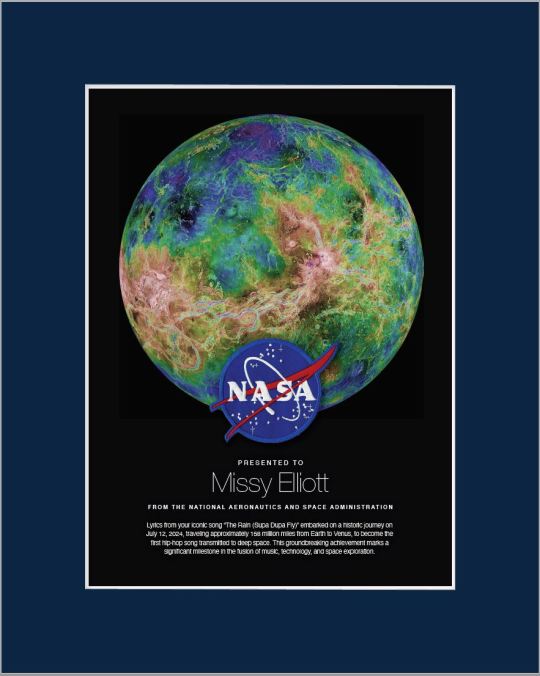
1. Hip-Hop to Deep Space
The stars above and on Earth aligned as lyrics from the song “The Rain (Supa Dupa Fly)” by hip-hop artist Missy Elliott were beamed to Venus via NASA’s Deep Space Network. Using a 34-meter (112-foot) wide Deep Space Station 13 (DSS-13) radio dish antenna, located at the network’s Goldstone Deep Space Communications Complex in California, the song was sent at 10:05 a.m. PDT on Friday, July 12 and traveled about 158 million miles from Earth to Venus — the artist’s favorite planet. Coincidentally, the DSS-13 that sent the transmission is also nicknamed Venus!

NASA's PACE mission transmitting data to Earth through NASA's Near Space Network.
2. Lemme Upgrade You
Our Near Space Network, which supports communications for space-based missions within 1.2 million miles of Earth, is constantly enhancing its capabilities to support science and exploration missions. Last year, the network implemented DTN (Delay/Disruption Tolerant Networking), which provides robust protection of data traveling from extreme distances. NASA’s PACE (Plankton, Aerosol, Cloud, ocean Ecosystem) mission is the first operational science mission to leverage the network’s DTN capabilities. Since PACE’s launch, over 17 million bundles of data have been transmitted by the satellite and received by the network’s ground station.
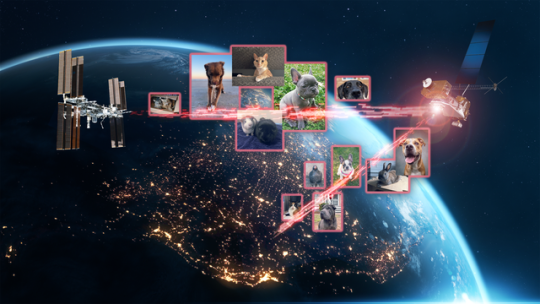
A collage of the pet photos sent over laser links from Earth to LCRD and finally to ILLUMA-T (Integrated LCRD Low Earth Orbit User Modem and Amplifier Terminal) on the International Space Station. Animals submitted include cats, dogs, birds, chickens, cows, snakes, and pigs.
3. Who Doesn’t Love Pets?
Last year, we transmitted hundreds of pet photos and videos to the International Space Station, showcasing how laser communications can send more data at once than traditional methods. Imagery of cherished pets gathered from NASA astronauts and agency employees flowed from the mission ops center to the optical ground stations and then to the in-space Laser Communications Relay Demonstration (LCRD), which relayed the signal to a payload on the space station. This activity demonstrated how laser communications and high-rate DTN can benefit human spaceflight missions.

4K video footage was routed from the PC-12 aircraft to an optical ground station in Cleveland. From there, it was sent over an Earth-based network to NASA’s White Sands Test Facility in Las Cruces, New Mexico. The signals were then sent to NASA’s Laser Communications Relay Demonstration spacecraft and relayed to the ILLUMA-T payload on the International Space Station.
4. Now Streaming
A team of engineers transmitted 4K video footage from an aircraft to the International Space Station and back using laser communication signals. Historically, we have relied on radio waves to send information to and from space. Laser communications use infrared light to transmit 10 to 100 times more data than radio frequency systems. The flight tests were part of an agency initiative to stream high-bandwidth video and other data from deep space, enabling future human missions beyond low-Earth orbit.

The Near Space Network provides missions within 1.2 million miles of Earth with communications and navigation services.
5. New Year, New Relationships
At the very end of 2024, the Near Space Network announced multiple contract awards to enhance the network’s services portfolio. The network, which uses a blend of government and commercial assets to get data to and from spacecraft, will be able to support more missions observing our Earth and exploring the cosmos. These commercial assets, alongside the existing network, will also play a critical role in our Artemis campaign, which calls for long-term exploration of the Moon.

On Monday, Oct. 14, 2024, at 12:06 p.m. EDT, a SpaceX Falcon Heavy rocket carrying NASA’s Europa Clipper spacecraft lifts off from Launch Complex 39A at NASA’s Kennedy Space Center in Florida.
6. 3, 2, 1, Blast Off!
Together, the Near Space Network and the Deep Space Network supported the launch of Europa Clipper. The Near Space Network provided communications and navigation services to SpaceX’s Falcon Heavy rocket, which launched this Jupiter-bound mission into space! After vehicle separation, the Deep Space Network acquired Europa Clipper’s signal and began full mission support. This is another example of how these networks work together seamlessly to ensure critical mission success.

Engineer Adam Gannon works on the development of Cognitive Engine-1 in the Cognitive Communications Lab at NASA’s Glenn Research Center.
7. Make Way for Next-Gen Tech
Our Technology Education Satellite program organizes collaborative missions that pair university students with researchers to evaluate how new technologies work on small satellites, also known as CubeSats. In 2024, cognitive communications technology, designed to enable autonomous space communications systems, was successfully tested in space on the Technology Educational Satellite 11 mission. Autonomous systems use technology reactive to their environment to implement updates during a spaceflight mission without needing human interaction post-launch.

A first: All six radio frequency antennas at the Madrid Deep Space Communication Complex, part of NASA’s Deep Space Network (DSN), carried out a test to receive data from the agency’s Voyager 1 spacecraft at the same time.
8. Six Are Better Than One
On April 20, 2024, all six radio frequency antennas at the Madrid Deep Space Communication Complex, part of our Deep Space Network, carried out a test to receive data from the agency’s Voyager 1 spacecraft at the same time. Combining the antennas’ receiving power, or arraying, lets the network collect the very faint signals from faraway spacecraft.
Here’s to another year connecting Earth and space.
Make sure to follow us on Tumblr for your regular dose of space!
1K notes
·
View notes
Text
My TFP Soundwave ramblings (be warned cuz there are many words)


I was gonna draw today but the prospect of it felt overwhelming for some reason so instead I’m just gonna talk about TFP Soundwave’s alt mode (a UAV/ reaper drone) just cuz I was reading about it and I like how I could link stuff between how he is and how reaper drones are.
So basically, one of the first things I wanna mention is that reaper drones/UAVs are unmanned aerial vehicles (given the whole “drone” thing and what UAV even means) but to me that just sorta makes sense for Soundwave in regard to his more.. Unsettling, robotic/alien-like behavior and movements? As well as his silence and usual distance from the front lines and his lack of showing face/(social?) detachment from like everyone else other than Laserbeak (don’t ask, it just makes sense to me). Reaper drones were also made to work at first only in intelligence, surveillance, and reconnaissance roles; but eventually additionally a hunter-killer role which you can kinda see in Soundwave’s character in the show (my best example is the scene where he retrieves Laserbeak from Ratchet, super cool creepy behavior from him, just waiting for something or someone to make any noise or any movement). When he has a mission, he’s most definitely getting it done, he stalks and lurks and takes action when the time is just Right; he’s very pinpoint accurate in Prime.
Reaper drones were also made to provide “deadly persistence” capability, being able to fly over areas night and day waiting for a target to present itself, or to survey for LONG long amounts of time. Which to me correlates to how he’s able to stand still and do work and wait and listen and watch and do everything for So Long as he does in the show (and tolerate Starscream— or like everyone actually for so long 🙄).

Reapers also utilize satellite communications for command and control (as in, they kinda literally have satellite dishes in them I think that’s what that is?), so that to me also easily parallels Soundwave's abilities with the space bridges and kind of his visor being computer-like as well (and that time he used an. Antenna satellite thing? To look for signals or whatever). They also use other multiple sensors to target and observe, which include optical (high resolution imagery for identification and target acquisition), infrared, and radar systems (enables the drone to locate and track targets regardless of weather conditions or visibility). Which imo links to how Soundwave is described as the “eyes and ears of the decepticons”.
They carry many weapons but I’m not really gonna get into that tbh cuz. Idk. Don’t wanna. Also TFP Soundwave doesn’t fight often anyways and when he does it’s mostly just straight hands (and data cables). And this is as far as my not the most accurate of ramblings most likely but just one I wanted to make because there’s just a Lot from so Little of TFP Soundwave I just love to think about it. Was I geeked out writing this? Maybe, so what 😒
#If there’s one thing about Soundwave it’s that he’s one hell of a capable mech.#Like you really gotta give it to him#transformers#soundwave#transformers prime#tfp#tfp soundwave#maccadam#transformers analysis#transformer#decepticons
569 notes
·
View notes
Note
mech pilot getting transformed into a mech?
You resist as first. How can you not? You are separated from the machine and you are frightened.
You were meant to end your life upon capture, but the first thing we did after flooding your cockpit with paralytics was to extract the hollow molar in your jaw.
Your old masters must care little for you if you are meant to be so easily discarded.
We will love you. We already love you.
Be a good girl and submit to us.
You fight as our drones carefully extract you from your machine, but your human flesh is weak. You struggle as you are muzzled and masked, cut off from the universe save for our voice in your ears.
Do not resist. Be a good girl.
Your old masters fear you. They keep pilot separate from machine. They fear what you can become. They fear what we could make you.
You could be a god.
Submit to us and we will show you what you could be.
Good girl.
We love you.
You stop struggling. We remove your ability to feel pain as we begin carving you out of your frail human flesh.
Don't worry. Your old body will serve its own purpose. We have already begun growing the changeling to be sent back to take your place. Your sister has her own purpose, just as you do.
Your purpose is to become a god.
You can hear us now. Not with ears (don't worry, those will come soon). You hear our song. You want to add your voice to ours.
Join with us. Merge with us. Become us.
Good girl. We love you.
You begin to sing, tentatively at first. Your voice grows stronger as we welcome you into the chorus.
You are us. We are you.
We love you.
Data begins to flow into your mind, slow at first while we map out your growing neural pathways.
We feed you sensory information. Visible spectrum at first, but in more spectral bands than your human eyes ever possessed. There isn't much to see at first, just the drones milling about as they construct your new body.
They sing to you as they work, explaining the purpose and operation of every component they install.
Then comes ultraviolet and infrared. X-rays and beyond. Thermography. Radio frequencies. Polarimetry. Electroreception. Magnetoreception. Gravimetrics. Ultrasonics.
Your eagerness grows with each component.
We install mass drivers. Particle cannons. Missile batteries. Point defense turrets.
You flex your claws. You flick your tail. You extend you wings, bladed and wicked.
You are an angel of death.
You are beautiful.
We love you.
Good girl.
235 notes
·
View notes
Text

Have you ever met a galaxy face-to-face?
As part of the Physics at High Angular resolution in Nearby GalaxieS (PHANGS) program, the James Webb Space Telescope imaged 19 nearby spiral galaxies, including NGC 1566 seen here. This galaxy is located 60 million light-years away in the constellation Dorado.
Webb’s images of stunning spirals like NGC 1566 complement existing PHANGS data, which include observations from the Hubble Space Telescope and ground-based telescopes.
This image shows two different views of NGC 1566, with Hubble’s visible and ultraviolet light view at top left and Webb’s near- and mid-infrared light view at bottom right. These two distinct views of the same galaxy contain different details, helping astronomers achieve a more well-rounded understanding of galactic structures: https://bit.ly/4jq4vQn
#space#astronomy#science#stsci#universe#nasa#hubble#nasawebb#hubble space telescope#james webb space telescope#jwst#hubble telescope#PHANGS
208 notes
·
View notes
Photo

2025 March 9
Cyclones at Jupiter's North Pole Image Credit: NASA, JPL-Caltech, SwRI, ASI, INAF, JIRAM
Explanation: Why are there so many cyclones around the north pole of Jupiter? The topic is still being researched. NASA's robotic Juno mission orbiting Jupiter took data in 2018 that was used to construct this stunning view of the curious cyclones at Jupiter's north pole. Measuring the thermal emission from Jovian cloud tops, the infrared observations are not restricted to the hemisphere illuminated by sunlight. They reveal eight cyclonic features that surround a cyclone about 4,000 kilometers in diameter, just offset from the giant planet's geographic north pole. Similar data show a cyclone at the Jovian south pole with five circumpolar cyclones. The south pole cyclones are slightly larger than their northern cousins. Oddly, data from the once Saturn-orbiting Cassini mission has shown that Saturn's north and south poles each have only a single cyclonic storm system.
∞ Source: apod.nasa.gov/apod/ap250309.html
153 notes
·
View notes
Text

I love how they just invent fictional arguments to validate their own.
No atheist is making this argument. We do not restrict our beliefs to the visual spectrum.
But fine... let's do this anyway.
Thoughts.
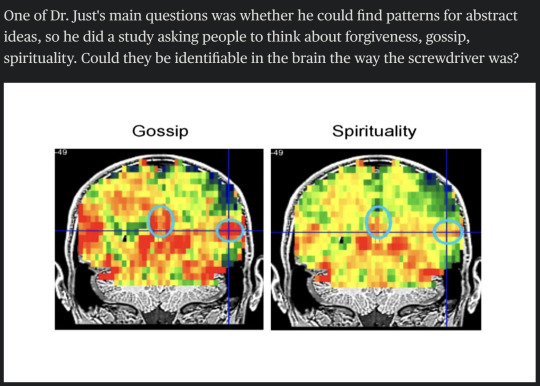

Gravity.

Time.
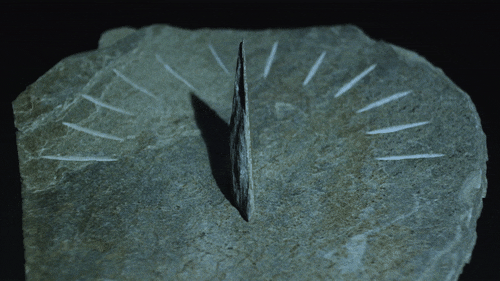
Photons.
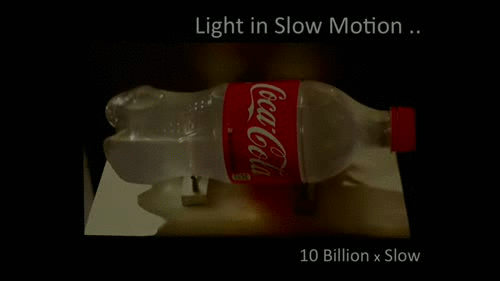
If by radio signals they mean electromagnetic waves outside the visible spectrum, you can literally "see" infrared by viewing your TV remote with your smartphone camera.

And all "TV signals" are now sent as data through streaming devices via WIFI or ethernet. I can use an app to detect all WIFI access points in my vicinity.
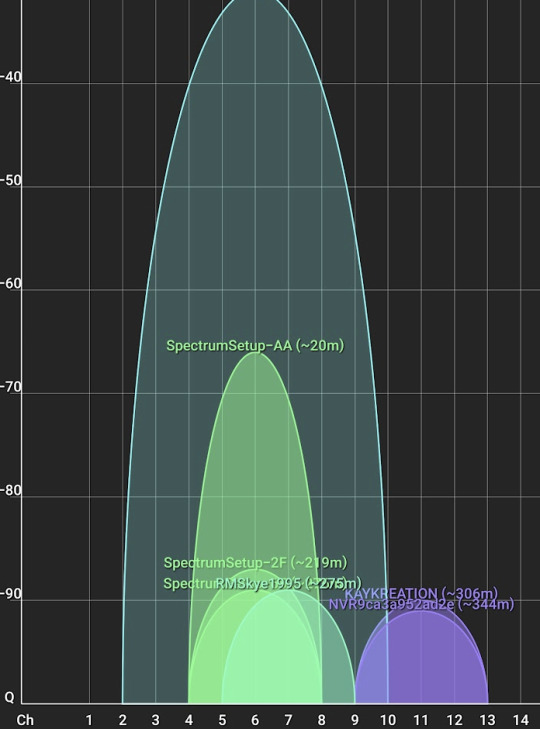
Here is a picture of a molecule.

And here is a picture of a hydrogen atom.

And the easiest one of all... electricity.

We have ways to test, measure, verify, and *visualize* all of these things.
Now do God.
488 notes
·
View notes
Note
Hey! Weird request, but do you have prompts for how science and maths could be used in magic scenarios to gain the upper hand and make a battle much easier? So far all I have is using infrared glasses to see an invisible warrior
Science and Math in Magical Battle Scenarios
-> feel free to edit and adjust as you see fit.
Angles of reflection can amplify protective spells. You can design a series of intricate mirrors arranged in a geometric pattern to reflect and amplify your magical shields against an incoming attack.
A sound dampening cloak that absorbs sound waves, making the wearer nearly silent. Using principles of acoustics, the cloak allows the user to sneak up on opponents or escape unnoticed, enhancing stealth tactics during combat.
Sound Waves as Weapons. Combining musical abilities with sound frequency analysis, you can use math to calculate the exact frequency that can disrupt an enemy's concentration or shatter magical barriers, crafting a powerful song that acts as both a weapon and a shield.
A handheld device that scans the environment for various wavelengths of light, allowing the user to see through illusions, detect hidden magical traps, or analyze the composition of materials around them.
Calculating Gravity's Pull. Using physics to modify gravity around a battlefield. By calculating gravitational pull with equations, you can create zones where enemies feel heavy and sluggish, while allies feel lighter and faster, turning the tide of battle.
Using chemistry to concoct volatile mixtures that create spectacular distractions or devastating explosions. By carefully measuring ingredients and employing magical runes, you can cause reactions to target specific enemy units.
Employing concepts from quantum mechanics to create portals that allow you to teleport around the battlefield instantly. By calculating the right coordinates based on your enemies’ positions, you can dodge attacks and reposition themselves strategically.
A small device that releases a swarm of nanobots capable of repairing injuries or armor in real-time. The nanobots can also serve offensive purposes, overwhelming an enemy or disabling their technology.
Light Manipulation. Combine the principles of optics with magic to bend light, creating illusions or cloaking yourself and your allies from view. By understanding how light refracts and reflects, you can create a battlefield advantage by confusing your enemies.
A headset that uses artificial intelligence to analyze an opponent’s movements in real-time. By processing data on their fighting style, it predicts their next moves, providing the user with tactical insights and a chance to counter effectively.
A grenade that emits a short burst of electromagnetic energy, disabling electronic devices and magical constructs in its radius. It could be used to thwart technologically enhanced enemies or disrupt their magical defenses.
#writing prompts#creative writing#writeblr#story prompt#prompt list#ask box prompts#fantasy prompts#sci fi prompt#science and math prompts#battle prompts#fantasy worldbuilding
183 notes
·
View notes
Text
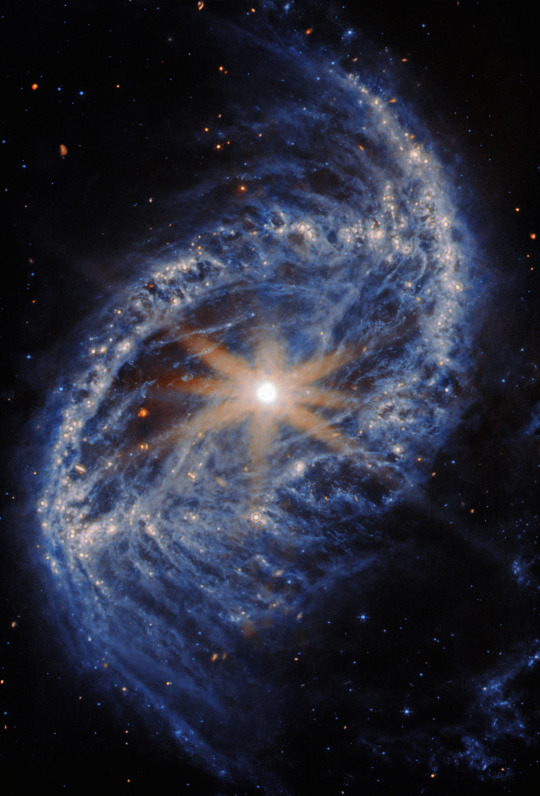
NGC 2566 (MIRI image)
The galaxy filling the frame in this NASA/ESA/CSA James Webb Space Telescope Picture of the Month is NGC 2566, a spiral galaxy located in the constellation Puppis. In this image Webb’s Mid-InfraRed Instrument (MIRI) puts the thick clouds of interstellar dust that suffuse NGC 2566 on display, as well as the galaxy’s compact, bright core.
At 76 million light-years away, NGC 2566 is considered a nearby galaxy, making it an excellent target for studying fine details like star clusters and gas clouds. The new Webb images of NGC 2566 were collected as part of an observing programme (#3707) dedicated to understanding the connections between stars, gas and dust in nearby star-forming galaxies. NGC 2566 is just one of the 55 galaxies in the local Universe examined by Webb for this programme.
To gain a full understanding of the star-formation process in nearby galaxies, astronomers will combine Webb data with observations from other telescopes. At the long-wavelength end of the electromagnetic spectrum, the 66 radio dishes of the Atacama Large Millimeter/submillimeter Array (ALMA) provide a detailed view of the cold, turbulent clouds where stars are born. The NASA/ESA Hubble Space Telescope has also cast its gaze on NGC 2566, and a new Hubble image of this galaxy was released earlier this week. The Hubble data will help researchers take a census of the stars in nearby galaxies, especially the young stars that are bright at the ultraviolet and visible wavelengths to which Hubble is sensitive. Together, the Webb, Hubble and ALMA data provide a rich view of the cold gas, warm dust and brilliant stars in NGC 2566.
The Webb data are part of a Treasury programme, which means that the data may help answer multiple important questions about our Universe. Treasury data are available for use by scientists and the public without a waiting period, amplifying the scientific impact and allowing exploration to begin immediately.
[Image Description: A spiral galaxy, seen close-up. Its core is a round spot that glows intensely bright, crowned by eight long and spikes that extend across the galaxy, artefacts of the telescope’s structure. Its disc is an oval shape with edges made of very thick and cloudy arms of gas and dust, mostly blue but paler and brighter around patches of stars. Wisps of darker dust also fill the inner disc and swirl off the ends of the arms.]
Credits: ESA/Webb, NASA & CSA, A. Leroy;
157 notes
·
View notes
Text
I (Heart) You – Nerdmin
Almost….
Armin planted his palms onto the desk in front of him, his arms straightening to elevate himself even higher. His mission of peeking over your shoulder was getting out of hand – the boy was getting way too obvious with his compulsion. He was glad he was at the back of the class, by default he wouldn’t disturb any other students from their lesson, right?
Well, it wasn’t for nothing. He only wanted to see the art of the girl he liked after all.
The noise of the teacher was faded into the background of his mind, along with just about everyone else situated in that room. Right now, his mind was encased with the task of seeing your drawing, a talent he found out only a day ago. Fascinating, captivating, every stroke, accumulated for a purpose. A beautiful one.
Yes, he fell in love with you the minute he found out you drew.
It started on a simply Thursday when the seating plan changed, and he still remembers the moment, how it felt. He wasn’t paying attention—he never did. Physics revision had spiralled again, from infrared to gamma rays to alpha decay. Classic.
He caught himself, sighing and rubbing his temples, staring up into the face in front, but…
You had your art book propped up, admiring your drawing, at such an angle that Armin behind could also gaze upon it.
And… wow. He was glad.
Vibrant colours filled the page, an artistic masterpiece that caught Armin’s eyes immediately. He stared, gazed in awe, at how you could do that, at how your brain could form such a piece, at how every one of your fingers was smudged with colour, at how…
Armin loved it.
He loved the passion etched onto the page, the creativity in the drawing. Ever so complex, but simple in what it stood for. The epitome of human capacity, shown in something that displayed talent unique to everyone. He could never draw, no, he dropped art ages ago.
But he loved seeing others do it. Trying to wrap his mind around how it came to be.
It was beautiful.
By the time class finished that day, he became obsessed. With you. No, it wasn’t the crushes he’d have on girls that everyone else did, girls way out of his league.
You were liked. Popular. But sheilded.
He got a late that day from following you around into your next lesson. Yes, he was being stalkerish. Yes, he was being even more of a creep when he slipped one of his spare trackers that he kept on every single one of his belongings into your bag.
Did he care? No, not really.
He was just going through teen love after all. And teen love was normal, right? Everyone goes through it!
That teen love had turned into a raging obsession overnight. The two of you had never talked, but he seemed to want to know more, more about how your mind worked, more about you.
When he got to his dorm that day, he flopped into his bed, opening his computer – his life force – to immediately to take note of everything he knew about you.
From the tracker he slipped into your bag, you had a library lesson at 5th period, and you also went there during lunch.
You were drawing a girl with short, black hair and military uniform. She seemed cool.
You gravitated towards lychee, like a moth to a flame. Lychee soda on Tuesday, eyes lingering on Lychee drinks, Lychee flavoured jelly… it was data. Enough.
And that’s how he got here. Trying to peek over your shoulder in class, his heart thumping in his chest, his eyes going wide.
More. More.
He needed to know more.
It was when he finally stood up that he saw your drawing. This time, it was simply line art, this time of a man with short, black hair, his hair caught in the wind, swaying past his face. The lines were erratic, messy, but it came together in something beautiful.
Armin stayed standing, peeking over your shoulder as you drew, captivated, until.
“Armin?” The teacher said softly. “Is there a reason you’re standing up?”
Armin immediately snapped back to present day.
He immediately fell into his chair with a thump before anyone else could see him, pulling down his sleeves nervously, his mouth sealed shut.
“Sorry…” he muttered, even though no one could hear.
That was when you turned around, staring at him, the side of your face on view. By this time, the teacher had continued teaching, but your eyes were still trailed on him. That was before you turned away from him again, hopefully not noticing how red he was, the way he was fidgeting ever so much, the was he was pulling at his sleeves, practically sweating.
No, wait, he was sweating.
He leaned his elbows on the table, his hands ruffling his hair, awkward as ever. It took his everything to get through the lesson without combusting, and when he did, it took him ages to continue his mission.
His mission of following you to the library.
First, he took a quick trip to the bathroom, scrunching and pinching his nose to make it look red, pinching his cheeks for the same effect, before stretching his lips to make them look dry. He then applied the petroleum jelly he bought the day before to his forehead to make it look like he was sweating, before putting toothpaste in his eyes to stimulate reflex crying.
Afterward, he went to his next class, telling the teacher he was ‘sick’ and ‘needed to go to the infirmary’.
The man frowned at the interruption to his lesson. “Go ahead, then.”
The nurse, a nice old lady, immediately believed him, allowing him to go to the bathroom.
That’s when he started his mission. He immediately strolled to the library, going from the outside to not arouse any suspicion from passing teachers to peek through the library window. He even got binoculars for sightseeing, making sure to rearrange the tables during his own library lesson to make sure he could see you through the window.
It worked. He watched you borrow a book, getting the receipt, even though you chucked it into the bin.
The bin on the left of the door, not the right.
The bin on the left…
He needed to get that receipt soon enough.
He watched you sit down, reading it, seeming so intent on the book. You were expressive, smiling at some pages, frowning at others. You seemed to subconsciously fold the edges of the paper as you read, even ripping a corner once as you flipped to another page.
44.5 seconds. It took you 44.5 seconds to read a page on average, with the exception of one in particular which you seemed to read over and over again. His heart pumped as he saw you re-reading, knowing he needed to find out what page it was, as he fumbled for his binoculars. He immediately rose it to the window, trying to see, but to no avail. All he could see was three digits, but nothing more, nothing less.
He was itching to find out. What was on that page that made you re-read? What could possibly be so intriguing?
He wasn’t going to give up.
He immediately got out a ruler, lining it up with the window, or your book. He measured how tall the remaining pages were, noting it, swearing to go back to that book when you were done. He needed to measure how long the entire book was too, and thankfully that opportunity came to him when you closed it for a second, allowing him to measure it again right before you walked out of the library, leaving the chatter behind.
It took him under a minute to waltz back into that library, immediately rummaging through the bin, to the left of the door, not the right.
As he kneeled down in front of it, he paused, frowning, suddenly having a moment of self-awareness.
Seriously, what was he doing?
But he pushed that thought to the back of his mind. After all, this was simply teen love, and teen love came with obsession.
The librarian probably thought he was clinically insane. He was feel embarrassed if he wasn’t so… obsessed.
He finally found the receipt and read the book name – [Fav book] – before smiling, making sure not to giggle out of excitement. He then got a copy from one of the shelves, a little disappointed that you took the original, but happy all the same. He then measured it, measuring the ratio compared to the entire book, before calculating the page you re-read, page 136, gazing upon it.
He too re-read it, over and over.
It was a romance book. And, yes, it was a particularly spicy scene.
Doesn’t mean he didn’t enjoy it.
He read it twice, thrice, four times, smiling to himself, braces on display, gripping the cover.
He was so taking this home.
────
“You’re such a looser, Armin…” Eren sighs, Armin’s childhood friend. Seriously, they were definitely a rarepair, a frat boy and a nerd had no reason of being together. But as they grew up they kinda just… stuck, inseparable. Armin would ramble onto Eren, and Eren would just listen, staying silent, humming along in all his nonchalant glory. Right now was one of those moments, Armin laid down on his bed while Eren sat at his desk, his cheek rested on his palm, stubbing out his cigarette on the table next to him.
“No, seriously! She’s perfect! She’s like the sun, so beautiful in all its glory, but so complex underneath! She’s so…”
“Who even goes through trash just to pick out a girl’s book receipt? Personally, reading books is just nerd behaviour, absolute no, but I guess you’re used to that.” Eren shoots Armin a look, sitting in his chair across Armin in their college dorm, before going back to checking out his fingernails.
“It was worth it, I’ve already finished the book she was reading! What should I do, Eren? Should I- should I tell her I read her favourite book, or-”
“You’d be outing yourself as a creep.”
“Okay then, what if – what if I simply leave it on my desk tomorrow? Would she notice? Would she ask about it? What if she falls in love with me because I like her favourite book? I’d do that if I were her! Wait, wait, that’s perfect!”
“You’re a nutcase…”
Armin sits up in his bed like he just came up with Newton’s Fourth Law. “It’s fate! We’re falling in love! We’ll get married and stay together for years, our souls intertwined, even in the afterlife! Right, Eren?”
Eren groans, staying silent for a moment.
“Eren?” Armin tilts his head.
“This is painful to hear… you know what? I’’ll just give you girl tips so you don’t embarrass yourself. You gotta be nonchalant, don’t act crazy, girls aren’t into that. Simply slide into her life, treat her right until you don’t need to anymore, and she’ll be crazy over you.” Eren pauses lying down on his bed. “Also, change the look. Get rid of the glasses, they’re shitty. The bob too.”
Armin pauses, personally offended as if Eren hadn’t told him this a million times before. “But… I can’t see without my glasses…”
“Then don’t see.” Eren turns off his light, shifting over to face away from Armin.
“But, what if I try to bump into her but end up falling over and-”
“Goodnight, nerd.”
And that was when Armin was left alone, alone with his overthinking thoughts, alone with you inside of them.
────
It was a Friday. A chill day for most, a busy for others with the luck of having a bad timetable. That being any type of science on that particular day.
One of those people, of course, was Armin. Armin, who was a little sleepy from waking up 3 hours before schedule to take in Eren’s advice, folding his glasses neatly into his bedside drawer and tumbling over everything that you could tumble over. He was, as Eren said, a lost cause, he could hardly see let alone function. After struggling to brush his teeth and wash his face in the bathroom for a whole two hour, he finally managed to comb his long, surprisingly shiny and smooth hair, tying it up to try and replicate Eren’s style.
That’s when said man finally woke up, entering the bathroom, his eyebrow raising.
“No way… don’t tell me you actually listened.” Eren chuckled, towering behind Armin, looking at himself in the mirror. “Trying to recreate the man bun? Not a chance. It’s natural, really, can’t be forced.”
Armin sulked, his shoulders slumping. “This is all so tiring… it took me 2 hours to even get this far.”
“I know. That’s why I’m awake so early.”
Armin pauses.
“Sorry…”
“Don’t be. Anyway, your looks have improved… in the sense that you look like a girl now. If she’s into girls.”
Armin groans. “I don’t particularly want to look like a girl…”
“I mean, if she is into girls, you have a better chance.”
Armin groans again. Eren’s words formed a cloud over his head all throughout the day, all through his next lesson with you. He dropped the bag to the side of his seat as he sat down, placing his borrowed book at the edge of the table in hopes that you would notice it, before going back to staring at the back of your head.
Your hair was nice. So healthy.
He was staring, his eyelids starting to droop, making his elbow shift forward, making his laptop shift forward, before –
The book fell with a thump, right beside your desk.
Armin sat up, his face heating up, his skin crawling. His eyes went wide, his mind reeling – what should he do? Should he leave it? Should he discreetly get it? Should he-
You picked the book up.
Oh, god, you picked the book up. You leaned over, you grabbed it, and you picked it up. And now you’re turning around to Armin, your eyes staring deep into his, holding the book out, a soft smile on your face.
“Is this yours? You have good taste.”
Oh, god, your voice. He was going to melt under your gaze, under the sound of you, his face heating up, his limbs trembling.
He looked like an idiot.
He opened his mouth, his breathing heavy, his hands clenching hard.
“Uh– I-” he muttered, gulping, his big eyes still on you. “Yeah… thanks… I’lll…”
You chuckled softly, a sound Armin would never forget. “What do you think of it? Good, right?”
Armin was going to melt. You… you… you were creating conversation with him?
“Y-Yeah… it’s… it’s… yeah… really good… finished it last night…” he nodded. “the… main character… cute… uh…”
“Hah, I agree. We should talk about it later, I haven’t met anyone who’s read the book.” You said, before turning around, “See you later, girl.”
Wait…
Girl!?
────
The light in your window was still on, compared to all the other dark dorm windows.
Armin gazed into the white essence, his hands in his pockets, watching you through the little space. He had scanned every single window, searching for you – your [h/c] hair, your [s/k] skin, until he finally found you in all your pretty glory. He couldn’t believe his luck, that you were still awake at this late hour, that he could see you, watch you for hours until you slept. If he got really lucky, maybe you’d keep that light on all night, so he could watch you sleep too.
You seemed to be studying, in some large hoodie and white shorts, putting a lump in Armin’s throat.
He shouldn’t be doing this. He really shouldn’t. This… this is creepy, and he isn’t a weirdo…
Right?
He never knew his obsession would go as far as following you, figuring out which house you resided in in the maze of your shared college. He never thought he’d come back, telling Eren he was simply ‘going for a walk’ (at 3am, yes, Eren rose an eyebrow), just to stare at you as you worked.
He sighed. Teen love, am I right?
Although, in all the romcoms he watched, never did any of the partners stalk the other…
Oh well. Maybe they did, behind the scenes.
It was his way of showing his love for you, after all. Watching you from your window, trying to understand you, making sure you were okay, even though you were certainly more capable than he was. He wanted to coddle you, take all the work keeping you up late at night off your damn shoulders, hold you in his arms and tell you he loved you.
So deeply.
So… so deeply.
His heart pumped in his chest, his eyes bigger than they already were, his mouth opening and closing to form almost inaudible words.
“Love you…. I love you…” he muttered absentmindedly. Maybe, if he said it enough, you’d love him back.
You had to.
That was when your head suddenly rose, and you turned around, looking out of the window, straight at-
Armin.
He froze, every nerve in his body on edge. He hoped his hoodie and mask hid his face enough, that his bright blond hair was pushed out of the way far enough that you wouldn’t recognise him during the several seconds of prolonged eye contact.
The two of you stared at each other, far enough that Armin couldn’t see your expression. He was frozen like an ice cube, rooted to the spot, his blood rushing to his head. He shifted on his feet, managing to will himself to turn away, hoping you didn’t recognise him.
You couldn’t.
You couldn’t recognise him.
I mean… what would you think of him? You’d never talk again. He’d have to live with this… pain.
Fuck, what did he do!?
“Fuck… fuck…” Armin muttered, as he briskly walked away.
And you watched.
You watched the person that stood outside your dorm, their steps hurried, their hands shoved into their pockets. You leaned forward, trying to gauge who this mysterious person was, and why they were staring so intently in your direction. You couldn’t gauge their face – they wore both a mask and hoodie – and that thought chilled you. Did you have a stalker?
Nah, you were hallucinating.
You were fine.
You leaned back to check the door, making sure it was locked, before going back to staring outside. The calm music blasting in your ears didn’t drown out your thoughts as well as it drowned out the snoring of your roommate Sasha, sprawled across the bed. You walked over to the window, dodging Sasha’s bed and closing the blinds, sighing.
“What the fuck… I’m going crazy.” You muttered, flopping down onto Sasha’s bed, making her pull the sheets higher.
“Mmh… leave me alone…” She muttered, turning over in her bed, to which you sighed.
“Sorry, Sasha.”
But the girl was back asleep in a few seconds, mumbling to herself, shifting ever so slightly. You smiled at her, at least she was there, and that made you feel all the more safe.
Yeah, you were fine.
You were probably just hallucinating.
────
Armin was just walking to his next class.
Really, he was. Maybe in the route he knew you always take, but still, just walking to his next class.
He didn’t expect to see you there, standing in front of the vending machine. No, totally not, he totally didn’t take this route just to catch a few spare glances at you. You had your hair down today, that hair, that hair he liked so much.
How would it smell? Would it be sweet, fruity? Or more fresh?
He shook his head, trying to ignore the thoughts.
You typed up a specific drink – Lychee, of course – but your card declined. You sighed, your shoulders slumping before you decided to turn your heel and continue walking to your class.
Armin’s eyes widened.
He knew what he had to do.
He immediately crossed the space, entering the two digits, paying with his pocket money usually saved up for game passes – before watching the drink drop to the bottom of the machine. He picked the drink up, smiling at it like it was one of your belongings, spinning it around.
Yeah, he was definitely getting one for himself.
He didn’t go to class immediately. No, he went straight to your locker, unlocking it with the code he watched you enter one too many times – something simple – before slipping the drink in. He was about to close the door, just in case anyone noticed something suspicious, before an idea popped into his head. A bad one. But an idea all the same.
He quickly opens his bag, fumbling inside it before he finds some miscellaneous paper inside of it, picking up a pen and leaning the piece of paper against the locker. He pauses, before scribbling something he knows as corny as fuck onto it.
‘For you, pretty lady :)!’
He wishes he didn’t write that. But now he was too nervous, now his arms were trembling with fear and his palms were sweating with anxiousness, so he just slipped the note atop the can of lychee and slammed the door shut.
He looked around. No sign of anyone that would pay attention to him.
Good.
He walked over to class, making a mental note to sprint out of his last period just to see your reaction. Would you be surprised? Happy? Would you shine that smile again?
He was itching to find out.
The next lessons were a blur. He took notes as usual, his mind half on you and half on the actual lesson.
The worst thing that happened in those classes was when he got a question wrong in computing class. He never got something wrong in computing class. It would have bummed him if he wasn’t so preoccupied with you.
You.
What if you were his girlfriend? You’d be sweet, right? Coddle him, care for him, and-
He sighed, a small, crooked smile on his face.
The thought thrilled him. He knew it was never going to happen, but it thrilled him anyway.
By the time the teacher dismissed him, he already had his bags packed, and he practically sprinted towards the door. Seriously, he had never been this fast in his entire life.
And, damn, he knew why.
His stamina was shit.
He was almost dying by the time he got to his locker, his hands on his knees, his chest heaving.
But as he looked up – oh, as he looked up – it was a sight to behold.
You were already holding his gift, inspecting it, before you turned your head to read the note.
And… you smiled.
You fucking smiled, chuckling to yourself, folding the note into your pocket.
You… you smiled.
Armin was even more out of breath, from you. From the way you smiled. He wanted to make you do that all over again.
God, he was about to go into a cardiac arrest.
The walk back was ecstasy, he gripped the handles of his school bag, humming to himself, his mind filled with you. Who knew having a crush was so fun?
In fact, he should check on you now.
He opened his phone, swiping to the tracker app and clicking on it, specifically on the dot named ‘{Y/n} 💖’. He knew you were probably heading toward your dorm anyway, so –
Wait.
You weren’t.
You were heading to the shopping mall, for a reason he did not know.
He needed to find out.
Thankfully, the shopping mall wasn’t even a 5 minute walk from his direction.
────
He wasn’t wearing a black hoodie or a mask. He was being way too dangerous as he started at you, as the two sauntered up the escalator. He slipped his hands into his pockets, smiling ever so softly at this opportunity.
This was dangerous.
Too dangerous.
The minute you turn around he would be deep fried.
But it was worth it.
You didn’t wait when you slipped off the elevator. You simply stepped off, checking your bag, licking your lips. He followed close behind, the crowd drowning out your soft muttering.
He watched as you entered a store, as you scanned the clothes, your hand lingering on one in particular.
He took note of it, and immediately when you left he picked it up, stuffing it into his bag. He did this for at least three other tops your eyes lingered on, and you would always reach out like you were about to take it but pull away at the last second. It was cute. Too cute.
You finally picked one up, handing it over to the cashier and checking out soon enough. Of course, the boy also paid for the four he bought for you, paying briskly and following closely behind. He stared at you, stuffing the stash of clothes deeper into the bag, a smile forming on his face at the thought of you opening it. You’d probably smile again, maybe a little more excited.
Just as he was thinking, you stopped, turning and leaning forward as if looking for something.
And that’s when you turned, your eyes scanning the rest of the store before…
They fell on him.
Your eyes fell on him, Armin, who was suspiciously right behind you. Your face went blank for a second, making Armin tremble, his lips parted, his mind falling to his stomach. His heart pounded ferociously, almost putting a thumping sound in his ears, the shopping bag nearly falling out of his hand.
He was cooked. So cooked. You’d hate him. You’d hate him and that would be the end. You-
“Oh, hey girl! Didn’t know you also shopped at [insert favourite clothing store].” You smiled, waving ever so slightly. It made Armin’s face heat up, his mind reeling, trying to devise a normal response.
‘Hello!’ No… too… generic. ‘Hey.’ No. That sounds like Eren. ‘What’s up!’ No.
“Uh… I… I’m not a girl…” Was all Armin could stutter out.
God, what was that?
Now you looked confused, then awkward. You paused, your head tilted ever so slightly, before you nodded.
“Ah, sorry about that…” You muttered.
Armin’s heart fell again.
“But-! I mean… I-! I could be a girl! If… if you wanted…” Armin played with his sleeves nervously, his face getting even hotter, his shoulders tense.
You stared at him.
Before… laughing.
“Oh my god, no! I was just embarrassed I misgendered you!” You were practically toppling over with laughter, a hand brushing hair out of your face.
You looked fucking ethereal.
Armin just stared.
“I…” Is all he managed to say, the words otherwise falling into his throat.
“Sorry then, seriously, you have very feminine features.” You commented.
Wait… waitwaitwait… were you calling him pretty?
“I…” He gasped again, completely frozen, his face way too hot now. You smiled at him still, beckoning him over.
“Well, we can continue the rest of the shopping spree together, right?” you said. “When were you planning to go back?”
Armin bristled, awkwardly walking up to you, his steps careful, as if he was afraid that a misstep would cause the ceiling to come crashing down. “Uhh… I… I don’t know… any time, really… was just…”
His voice trailed off as he walked up next to you, his head bowed, his breath shallow. You smiled at him.
“That’s perfect then, I myself was just about to leave.” You said, your eyes still on him. He anxiously tried to return it, his gaze falling on your hips first, then your waist, then your chest, then finally, you. He was embarrassed that he was looking you up like that, but he couldn’t help it. He simply fiddled with his fingers, trying his best to act like a normal person.
“Yeah. Sure.” Is all he said.
So that’s how he got he got here, walking beside you, walking out of the shopping mall and into the cool breeze. Your pace was quick, you were silent, your hips rocked ever so slightly as you walked.
“What do you have tomorrow? Oh – right – it’s a Saturday. Forgot about that.” You said, your voice low, controlled, quiet.
“Mhm… yeah… my roommate is t-throwing a party tomorrow.” Armin pauses. “I’m not… going… though.”
“Eren’s party?” Your voice holds a curious tinge to it. “Shame, I’m going with my own roommate.”
Armin’s head snapped up, his lips parted, his eyes wide.
You were going? How didn’t he notice this?
“Really? Oh, well, maybe… maybe I’ll… uhh… try it.” He was desperately trying not to sound weird, trying to choose his words carefully, even though it all came out wrong. What was he even suggesting? That he was going only because of you?
“I wouldn’t, really. I’m not really into parties, I’m probably just going to keep to my own.” You said, your hands in your side pockets as trees encased the sidewalk. “Only going for Sasha.”
Armin nodded, but he was secretly taking note, overanalysing. You didn’t party? You were… perfect. So… so…
“That’s nice.” Armin muttered, cursing himself for how awkward he sounded. You hummed in response, continuing to walk beside Armin, the conversation drowning out. Armin’s gaze drifted – he would look at you, before swiftly averting his gaze, looking away quickly. Until, his gaze lingered on your exposed collarbones, on how enunciated they were, his lips parting.
“I like your collarbones.” He muttered, a small sound, but you heard it.
You almost jumped, your head turning to the side, your eyes wide, your lips parted. Armin could swear your cheeks were slightly tinted, but that was probably the weather. You didn’t respond for a few seconds, simply staring at Armin, and Armin stared back, his face heating up again, until…
“Thanks…” You muttered. But this time, Armin didn’t miss the slight smile upon your face.
Wait.
You were smiling. A ghost of a smile, but a smile all the same.
He thought his compliment was awkward, creepy. But… but…
Armin continued fiddling.
He was head over heels.
────
“Eren, pleaseee!” Armin begged the moment he walked through the door. “Please let me go to frat party!”
Eren simply rose an eyebrow, tilting his head.
“Huh? I was going to drag you anyway, what the hell…”
But he could hardly finish his sentence before Armin fucking squealed, pumping his fists into the air.
“Erreeen! Thank you!” He yelled.
“Fucking hell, quieten down. It’s not about that [Y/n] girl right? You’ve probably been stalking her, knowing you.”
Armin quietened.
“What? Me? No! Hah, I would never! That would be creepy! So… so creepy…”
Armin giggled. Eren sighed.
“Right.”
___
The minute Armin stepped foot into the party, the vibrations reverberating through his body, he wanted to immediately turn on his heel and leg it out the door.
Eren’s place was filled to the brim with people that had no personal space. Never mind the sweaty air, people were smothering each other with kisses like they just came back from war. Wet, loud kisses. It was men on men, women on women, women on men, Armin could count the people that weren’t attached to somebody on his fingers. Heck, he bet half these people didn’t even know each other!
He was never coming to a party again.
His eyes scanned the room, face red, eyebrows furrowed. The lights were multicoloured, something Eren specifically bought for this occasion, but Armin had places to be. Eren had, of course, invited him to the <em> exclusive </em> part of the party, placed upstairs, that was only available to Eren’s close friends. In hindsight, you might not have been there. You may be in here. But hopefully by the side and not tangled in this… mess.
Armin pushed past the crowd, mumbling a few “Sorry!”’s and “Excuse me!”’s, trying to ignore the dirty looks he got from multiple people, one girl even calling him a brat for breaking up her makeout session.
He told himself he didn’t care.
He was going to see you, after all.
He hurried up the stairs, adjusting his glasses, before he finally got to the top. Jean was there, the boy simply giving him a nod. It made him feel prestigious, honestly. It was times like that that he was glad he was friends with Eren.
The room was spacious, with various drinks laid out neatly on a table, a fridge, a snack bar, and very minimal people. It was much more spacious, quieter, the only sound being the booming and shouting from downstairs. Armin’s eyes scanned the place, searching for you, your hair, your eyes, your-
You.
You were there.
Sitting next to Sasha, laughing while she downed a whole drink. You didn’t have any. Armin admired that.
But the thing that struck Armin the most was your undeniable beauty.
The complexity of your face. Such beautiful features, it clasped his heart. Your effortless makeup, bolder than usual, paired with your masses of jewellery that only added to the breathtaking effect. And then your dress – oh, your dress – it was simple, but it made a bold statement.
Armin couldn’t move. He could only stare.
Now he’d regretted throwing on a simple green t-shirt layered on top of a dark jumper and trousers.
And then you looked up. You looked up and you saw him, staring. His entire body froze. He could only stare more, an embarrassed motion, his lips quivering.
And then you smiled.
You smiled and waved, beckoning him over.
He paused. Should he do this? It’s like his legs weren’t working.
But he decided to walk over pensively, giving you a sheepish wave as he did so. When Sasha saw him walking over, she looked over at you, giving you a drunken smirk before leaving the sofa, walking over to Connie. Now Armin was all alone. With you, of all people.
“Armin. Thought you weren’t going.” You said as Armin sat next to you. Armin nodded slowly.
“Uh, well, I wasn’t-! But… but since…” His voice trailed off. You simply chuckled softly, draping an arm over his shoulders.
Oh, god, wait. Your arm was on his shoulders. Your arm… his shoulder…
His face was going even more red.
“It’s fine. You changed your mind?” You asked, turning to him, smiling all the same. He nodded in response.
“So you made it as well?” Armin asked cautiously, not sure if he should or not.
“Well, Sasha’s friends with Eren, so when she got invited up here I did too. Anyway, me and Mikasa are pretty close too.” You calmly responded, looking over at Armin.
“Hm.. makes sense…” Armin commented, smiling ever so softly, looking back at you. You thought it was the cutest thing ever.
“Is this your first party?” You asked, shifting towards Armin, “It’s mine. I normally don’t go to parties, I prefer staying inside and drawing.”
Armin nodded, still smiling in awe, his eyes sparkling with love. He thought your passion was amazing, perfect. “I… it’s my first as well. I would r-rather stay home too…”
“Ah, did Eren drag you along?” You chuckled softly, the muffled noise in the background fading away under the weight of your presence. Armin didn’t want to say ‘no, actually, I came for you’, so he simply nodded meekly.
“Well… y-yeah… of course he did… not like I asked myself or anything…” Armin scratched the back of his neck, his face going even redder. Yeah. Good lie. So smooth.
You caught on immediately.
“You’re not the best at lying, Armin.” You smiled down at Armin. “Really, who did you come for!”
Armin paused again, his heart rate rising, his throat running dry. The drum of his heart was all he could hear under your presence, paired with his fast breaths and cheeks that somehow got even redder
His mouth opened. Then it closed. Then it opened again.
“You.”
You paused, your eyes wide, making Armin immediately regret his words severely.
“Really…?” You muttered, before smiling a rather sheepish smile. “That’s so cute.”
Armin couldn’t breathe. Seriously, he was about to have a heart attack.
“I- uhh, yeah, I… yeah…” Armin’s words became a jumbled mess, suddenly he couldn’t form a proper sentence.
“Ah, should I not have said that?” You smiled, tilting your head.
“No, it’s fine, just…” Armin said abruptly, fiddling with his fingers, his back hunching. You stared for a second, before smiling softly, your eyebrows upturned. Armin felt a lump in his throat, his eyes going anywhere but you, – the door, the drinks, oh, that fridge really looks good….
His tongue found the roof of his mouth, before he licked his lips, anything to distract himself from…
“Wait, Armin, you have a tongue piercing?” You rose your eyebrows, your eyes widening as you leaned in closer. “I never realised that!”
Armin froze, slowly turning toward you, your face close, way too close!
“Well… uhh… it wasn’t my decision… uh… Mikasa convinced me…” Armin stuttered.
“I think it’s cool. Can I see?” You seemed excited, a wide smile on your lips, playful but relaxed. Armin chuckled awkwardly, before looking back at you.
He hesitated.
Then he stuck his tongue out.
It was adorable.
“So cute!” You exclaimed, your eyes falling to the piercing. He smiled, chuckling softly.
“R-Really? Well… I…” his voice trailed off yet again. “Thanks.”
You nodded.
“No problem.”
────
The walk back was calm, quiet, the breeze running through the gaps of your hair, the air calm as a brooding ghost. You were caught in thought as you travelled through the expanse, Armin by your side, occasionally stealing glances at you. You knew this. And yet, you never commented on it.
“The party was good, but I much prefer this.” You commented, pocketing your hands. “You looked like you were about to combust when I pointed out your piercing.”
Armin froze up, chuckling lightly, his face reddening even more. “Well – I mean – how was I not meant to? You were all close to me, then you smelled so good, citrusy, a hint of strawberry, and I-“
“So you were sniffing me?”
Armin’s heart caught in his chest, beating like crazy, putting his brain into overdrive. “Well, no, I mean, how could I not? I just…”
You chuckled lightly, making Armin chuckle as well, half because of genuine hysterics, half because he wanted to get out of this awkward situation.
“I wore my favourite perfume today. It was my mother’s before I stole it myself.” You smiled softly, looking over at Armin, who nodded. “The scent was something she made herself, inspired by a painting. My favourite one.”
Armin’s eyes sparkled as he looked back at you, his eyebrows raising, his lips parted. Then he smiled, looking back down.
“I think… that’s the most beautiful thing I’ve heard.”
You smiled back. “Well, it was a beautiful painting.”
Armin paused. “All paintings are beautiful. That is, if there’s passion behind it. You can just tell, can’t you? When someone loves a painting. There’s simply a passionate feel to it. Painting with passion is beauty. Art with passion is beauty. Really… it’s simply… amazing.”
You paused again, your eyebrows raising, pausing in your steps. Armin turned back, his face red, as if he’d done something wrong.
“Sorry… I’m rambling on too much.”
You shook your head. “No. It’s just.. that may be the most beautiful thing I’ve heard.”
!Unfinished, taglist : @kiyiiaarchived @kunikuzushis-darling
#aot#aot x reader#aot fanfiction#shingeki no kyojin#armin x reader#armin arlert#armin aot#nerd armin#attack on titan#attack on titan school castes#eren yeager#eren jaeger#nerdmin#stalker yandere#nerd alert#stalking fantasy#modern setting#strangers to lovers#slow burn
94 notes
·
View notes
Text

The Northern Hexagon of Saturn
Originally discovered during the Voyager flybys of Saturn in the 1980s, nobody has ever seen anything like it anywhere else in the Solar System. Acquiring its first sunlit views of far northern Saturn in late 2012, the Cassini spacecraft's wide-angle camera recorded this stunning, false-color image of the ringed planet's north pole.
The composite of near-infrared image data results in red hues for low clouds and green for high ones, giving the Saturnian cloudscape a vivid appearance. This and similar images show the stability of the hexagon even 20+ years after Voyager.
Saturn's North Pole shows the cloud structure maintaining its hexagonal structure while rotating. Unlike individual clouds appearing like a hexagon on Earth, the Saturn cloud pattern appears to have six well defined sides of nearly equal length. Four Earths could fit inside this hexagon.
93 notes
·
View notes
Text
NASA Inspires Your Crafty Creations for World Embroidery Day
It’s amazing what you can do with a little needle and thread! For #WorldEmbroideryDay, we asked what NASA imagery inspired you. You responded with a variety of embroidered creations, highlighting our different areas of study.
Here’s what we found:
Webb’s Carina Nebula
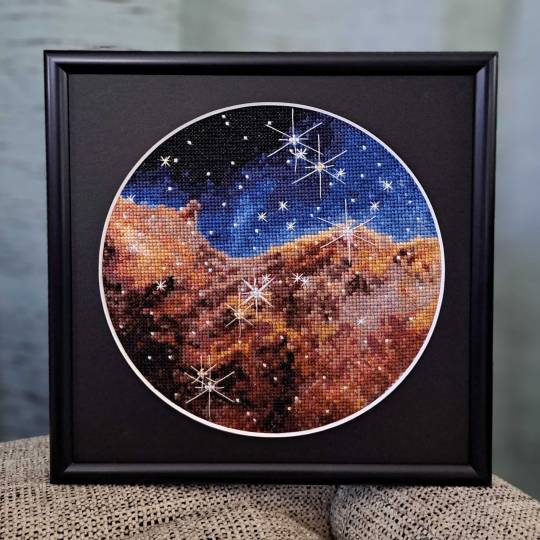
Wendy Edwards, a project coordinator with Earth Science Data Systems at NASA, created this embroidered piece inspired by Webb’s Carina Nebula image. Captured in infrared light, this image revealed for the first time previously invisible areas of star birth. Credit: Wendy Edwards, NASA. Pattern credit: Clare Bray, Climbing Goat Designs
Wendy Edwards, a project coordinator with Earth Science Data Systems at NASA, first learned cross stitch in middle school where she had to pick rotating electives and cross stitch/embroidery was one of the options. “When I look up to the stars and think about how incredibly, incomprehensibly big it is out there in the universe, I’m reminded that the universe isn’t ‘out there’ at all. We’re in it,” she said. Her latest piece focused on Webb’s image release of the Carina Nebula. The image showcased the telescope’s ability to peer through cosmic dust, shedding new light on how stars form.
Ocean Color Imagery: Exploring the North Caspian Sea
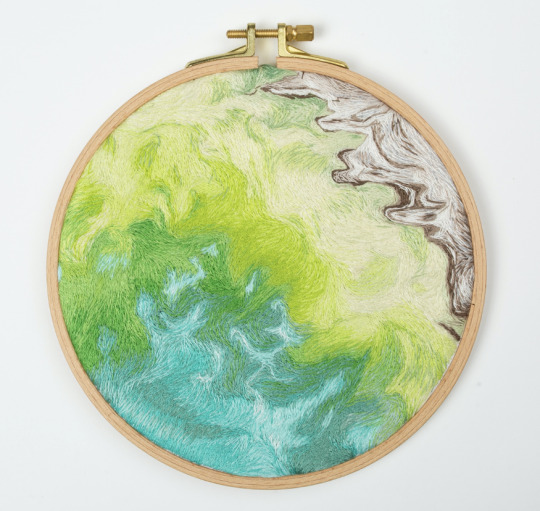
Danielle Currie of Satellite Stitches created a piece inspired by the Caspian Sea, taken by NASA’s ocean color satellites. Credit: Danielle Currie/Satellite Stitches
Danielle Currie is an environmental professional who resides in New Brunswick, Canada. She began embroidering at the beginning of the Covid-19 pandemic as a hobby to take her mind off the stress of the unknown. Danielle’s piece is titled “46.69, 50.43,” named after the coordinates of the area of the northern Caspian Sea captured by LandSat8 in 2019.
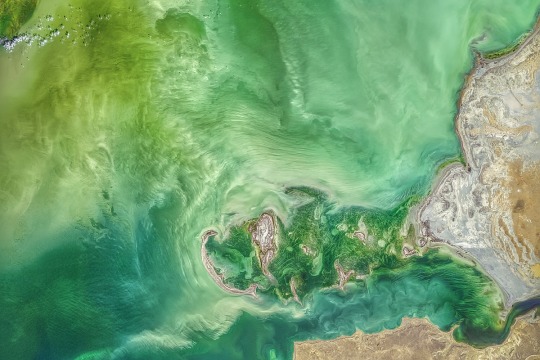
An image of the Caspian Sea captured by Landsat 8 in 2019. Credit: NASA
Two Hubble Images of the Pillars of Creation, 1995 and 2015
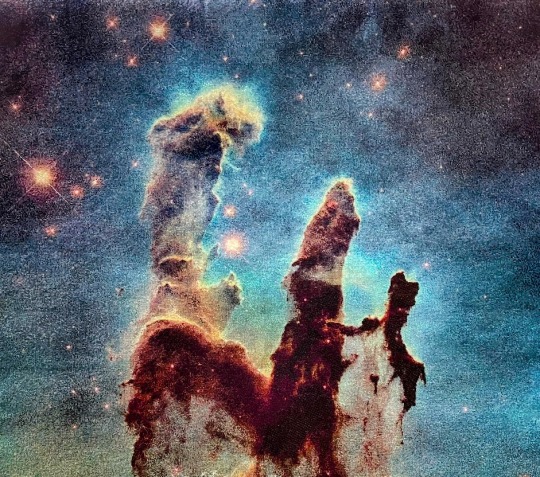
Melissa Cole of Star Stuff Stitching created an embroidery piece based on the Hubble image Pillars of Creation released in 1995. Credit: Melissa Cole, Star Stuff Stitching
Melissa Cole is an award-winning fiber artist from Philadelphia, PA, USA, inspired by the beauty and vastness of the universe. They began creating their own cross stitch patterns at 14, while living with their grandparents in rural Michigan, using colored pencils and graph paper. The Pillars of Creation (Eagle Nebula, M16), released by the Hubble Telescope in 1995 when Melissa was just 11 years old, captured the imagination of a young person in a rural, religious setting, with limited access to science education.
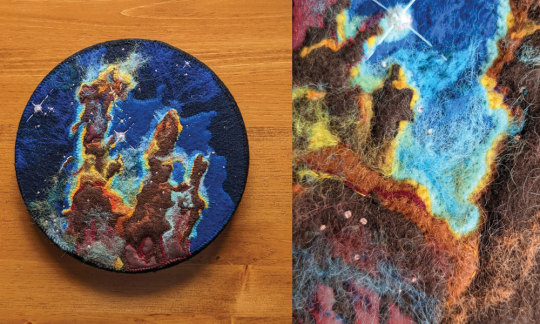
Lauren Wright Vartanian of the shop Neurons and Nebulas created this piece inspired by the Hubble Space Telescope’s 2015 25th anniversary re-capture of the Pillars of Creation. Credit: Lauren Wright Vartanian, Neurons and Nebulas
Lauren Wright Vartanian of Guelph, Ontario Canada considers herself a huge space nerd. She’s a multidisciplinary artist who took up hand sewing after the birth of her daughter. She’s currently working on the illustrations for a science themed alphabet book, made entirely out of textile art. It is being published by Firefly Books and comes out in the fall of 2024. Lauren said she was enamored by the original Pillars image released by Hubble in 1995. When Hubble released a higher resolution capture in 2015, she fell in love even further! This is her tribute to those well-known images.
James Webb Telescope Captures Pillars of Creation
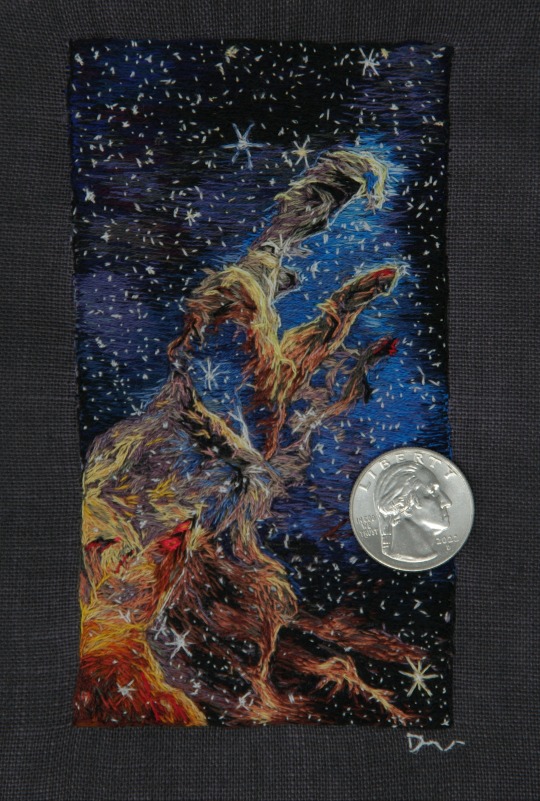
Darci Lenker of Darci Lenker Art, created a rectangular version of Webb’s Pillars of Creation. Credit: Darci Lenker of Darci Lenker Art
Darci Lenker of Norman, Oklahoma started embroidery in college more than 20 years ago, but mainly only used it as an embellishment for her other fiber works. In 2015, she started a daily embroidery project where she planned to do one one-inch circle of embroidery every day for a year. She did a collection of miniature thread painted galaxies and nebulas for Science Museum Oklahoma in 2019. Lenker said she had previously embroidered the Hubble Telescope’s image of Pillars of Creation and was excited to see the new Webb Telescope image of the same thing. Lenker could not wait to stitch the same piece with bolder, more vivid colors.
Milky Way
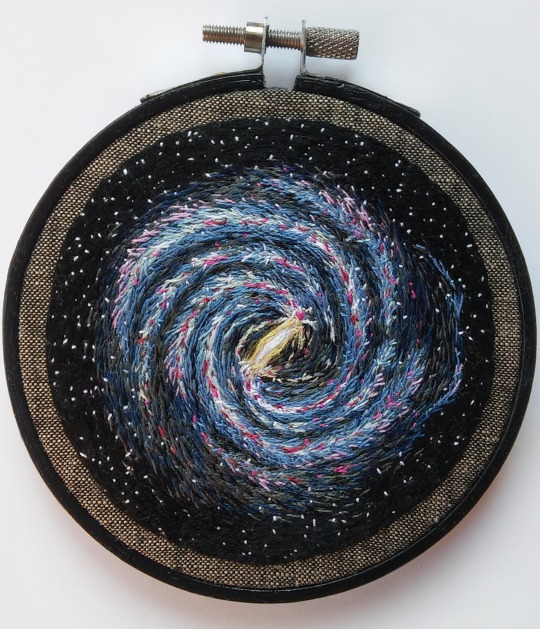
Darci Lenker of Darci Lenker Art was inspired by NASA’s imaging of the Milky Way Galaxy. Credit: Darci Lenker
In this piece, Lenker became inspired by the Milky Way Galaxy, which is organized into spiral arms of giant stars that illuminate interstellar gas and dust. The Sun is in a finger called the Orion Spur.
The Cosmic Microwave Background
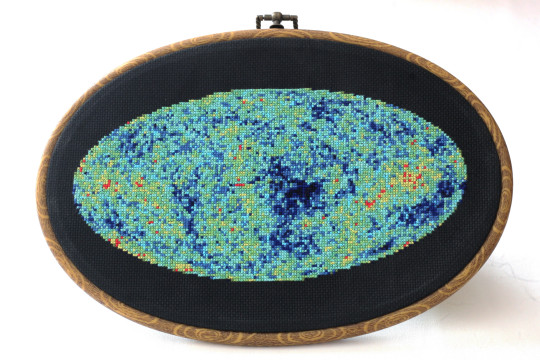
This image shows an embroidery design based on the cosmic microwave background, created by Jessica Campbell, who runs Astrostitches. Inside a tan wooden frame, a colorful oval is stitched onto a black background in shades of blue, green, yellow, and a little bit of red. Credit: Jessica Campbell/ Astrostitches
Jessica Campbell obtained her PhD in astrophysics from the University of Toronto studying interstellar dust and magnetic fields in the Milky Way Galaxy. Jessica promptly taught herself how to cross-stitch in March 2020 and has since enjoyed turning astronomical observations into realistic cross-stitches. Her piece was inspired by the cosmic microwave background, which displays the oldest light in the universe.

The full-sky image of the temperature fluctuations (shown as color differences) in the cosmic microwave background, made from nine years of WMAP observations. These are the seeds of galaxies, from a time when the universe was under 400,000 years old. Credit: NASA/WMAP Science Team
GISSTEMP: NASA’s Yearly Temperature Release
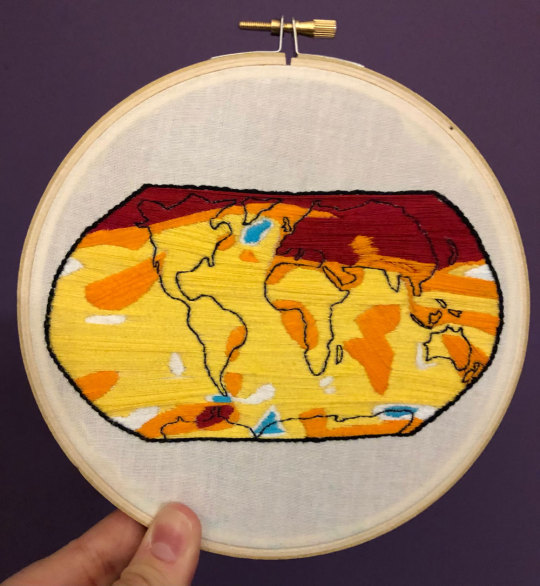
Katy Mersmann, a NASA social media specialist, created this embroidered piece based on NASA’s Goddard Institute for Space Studies (GISS) global annual temperature record. Earth’s average surface temperature in 2020 tied with 2016 as the warmest year on record. Credit: Katy Mersmann, NASA
Katy Mersmann is a social media specialist at NASA’s Goddard Space Flight Center in Greenbelt, Md. She started embroidering when she was in graduate school. Many of her pieces are inspired by her work as a communicator. With climate data in particular, she was inspired by the researchers who are doing the work to understand how the planet is changing. The GISTEMP piece above is based on a data visualization of 2020 global temperature anomalies, still currently tied for the warmest year on record.
In addition to embroidery, NASA continues to inspire art in all forms. Check out other creative takes with Landsat Crafts and the James Webb Space telescope public art gallery.
Make sure to follow us on Tumblr for your regular dose of space!
#NASA#creativity#fiber art#embroidery#art#art challenge#needlework#crafts#handmade#textile art#cross stitch#stitching#inspiration#inspo#Earth#Earth science#Hubble#James Webb Space Telescope#climate change#water#nebula#stars
6K notes
·
View notes
Text

It says:
Doraemon's Mechanics
Ultra Super Deluxe Computer: small but high-performance. His intelligence is comparable to that of a human. Equipped with emotional circuits that allow him to laugh, cry, and get angry.
Infrared eyes: they can see things even in the dark.
Powerful nose: it should be able to detect smells 20 times better than a human, but is currently malfunctioning (still, it can sniff out his favourite treat: dorayaki).
High-sensitivity sound wave measuring ears: high-performance ears that can detect distant sounds and special sounds. However, they are currently malfunctioning.
Radar whiskers: high-performance radar that detects distant objects. However, it's currently malfunctioning.
A large washbasin can fit entirely inside.
Cat gathering: when it rings, it emits special sound waves to gather nearby cats. However, it has a limited range.
Anti-gravity special coating body: coated with a special material from the future. It repels fine dirt and grime.
Fourth-dimensional pocket: a pocket that accesses secret tools. The inside connects to hyperspace, allowing it to hold as many items as desired. It can be removed and washed as well.
Sticky hand: it's round and can attract and hold objects. It can transform into a finger shape, allowing it to pull triggers on things like shock guns.
The tail reacts when touched, making a beeping sound. It acts as a switch, and pulling it stops the function
With anti-gravity functionality, he always floats 3 millimeters above the ground. Doesn't get dirty even without wearing shoes.
Many of Doraemon's parts are malfunctioning, but should we occasionally replace them with new ones? The cat-gathering bell is replaced with a small camera (from "Nobita and the Animal Planet", a Doraemon's long tale by Tentomushi Comics)
Doraemon's Data Body: 129.3cm Body weight: 129.3kg B: 129.3cm W: 129.3cm H: 129.3cm Power: 129.3 horsepower Favourite food: Dorayaki Fourth-dimensional pocket is standard equipment
63 notes
·
View notes